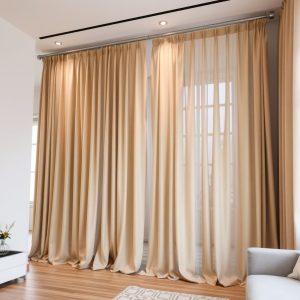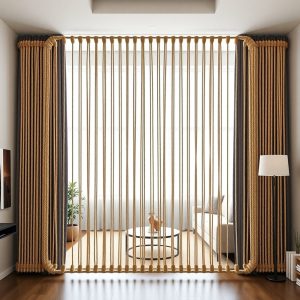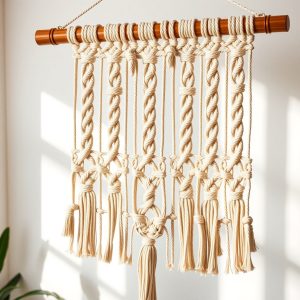
DIY Divider Ideas That Redefine Space and Style

Small spaces don’t have to feel cramped or chaotic. Clever dividers can introduce structure, privacy, and a fresh design perspective without major renovations. A well-placed room divider turns a single room into a multi-functional space that feels thoughtful and intentional. Whether it’s a cozy reading nook or a hidden workspace, these DIY ideas help define areas while adding personality to your home.
Houseplants, recycled materials, fabric panels, and even bookshelves offer easy and affordable ways to build visual boundaries. With a little creativity and basic tools, you can craft something stylish that suits your space and lifestyle. These ideas go beyond function—they double as eye-catching design features.
Not every home needs walls to feel organized. Some simply need a smart solution that sparks conversation and complements the flow of daily life. These DIY divider projects offer that balance—blending beauty with utility. Tackle one over the weekend and watch your space shift from open and undefined to stylish and segmented. Dive into these ideas that offer privacy without isolation and structure without stiffness.
Table of Contents
ToggleDIY Divider Ideas: 10 Simple Ways to Add Style and Privacy
Room dividers are more than just practical. They help you create cozy corners, private zones, or stylish features in your home. You don’t need to buy expensive screens or hire a contractor. With simple tools and easy steps, you can make your own dividers at home. Let’s look at 10 DIY divider ideas you can try today.
1. Curtain Divider

Materials: Curtain rod, curtains or fabric, hooks, drill, screws
Steps:
- Measure the space where you want the divider.
- Fix the curtain rod to the ceiling or walls using a drill and screws.
- Hang the curtains on the rod.
This idea works well for bedrooms, studio apartments, or shared rooms. You can change the fabric anytime. Light fabrics allow light to pass through. Darker ones give more privacy.
2. Bookcase Divider
Materials: Open-back bookcase, paint (optional), books or decor items
Steps:
- Choose a tall, open-back bookcase.
- Paint it if you want to match your room.
- Place the bookcase where you want to divide the space.
- Fill the shelves with books, plants, or small storage boxes.
This divider gives you both function and form. It holds your items and separates space without blocking light.
3. Rope Wall Divider

Materials: Wooden frame, strong rope, hooks or nails, drill
Steps:
- Build a wooden frame or use an old one.
- Drill holes at the top and bottom of the frame.
- Thread the rope from top to bottom.
- Tie knots to keep ropes in place.
This divider looks great in rustic or modern homes. You can make the pattern tight or loose. Add a few fairy lights for a soft look.
4. Hanging Planter Divider
Materials: Hanging planters, ceiling hooks, small plants, chain or rope
Steps:
- Fix ceiling hooks in a straight line.
- Hang the planters using rope or chain.
- Fill them with plants like pothos or ivy.
This idea adds green beauty and breaks space gently. Great for living rooms or balconies.
5. Folding Screen Divider

Materials: Wood panels, hinges, screws, paint or fabric (optional)
Steps:
- Cut three or more panels of wood.
- Attach them using hinges.
- Paint or cover with fabric for style.
A folding screen is easy to move and store. You can change its shape anytime. Decorate it with fabric, wallpaper, or paint.
6. PVC Pipe Divider
Materials: PVC pipes, joints, fabric, glue, scissors
Steps:
- Cut PVC pipes to make a frame.
- Connect the pipes with joints.
- Drape fabric over the frame.
- Glue or pin fabric in place.
PVC dividers are light and budget-friendly. You can take them apart easily. Try colorful fabric to brighten the room.
7. Bamboo Stick Divider

Materials: Bamboo sticks, wooden base, glue or nails, paint (optional)
Steps:
- Fix bamboo sticks in a wooden base.
- Make sure they stand straight.
- Paint the sticks if you like.
This idea works best near windows or patios. Bamboo gives a natural look. It also allows airflow and light.
8. Sliding Door Divider
Materials: Sliding door kit, wooden door or panel, drill, screws
Steps:
- Fix the sliding door track to the top wall.
- Hang the door or panel on the track.
- Slide to open or close space.
This divider saves space and adds charm. Works well between kitchen and dining or bedroom and closet.
9. Macrame Divider

Materials: Thick yarn or rope, wooden dowel, hooks, scissors
Steps:
- Tie yarn or rope on a dowel.
- Make knots in your favorite pattern.
- Hang the dowel on wall hooks.
Macrame looks soft and stylish. It suits boho or cozy homes. Choose white or beige for a light look.
10. Old Door Divider
Materials: Vintage doors, hinges, paint, sandpaper
Steps:
- Clean and sand the old doors.
- Paint if needed.
- Connect with hinges to make a screen.
Old doors add character. Use them in large rooms or entryways. Try different sizes for a creative feel.
FAQs
What is the easiest DIY divider to make?
A curtain divider is the easiest. It only needs a rod, fabric, and some screws.
Which divider is good for small rooms?
Try hanging planters or rope walls. They save space and don’t feel heavy.
Can I use these dividers in rental homes?
Yes. Use non-drill hooks or tension rods for curtain or macrame dividers.
Do these dividers block sound?
Not fully. They give visual privacy but don’t block sound.
Where can I use dividers at home?
Try them in bedrooms, living rooms, home offices, or balconies.
Conclusion
DIY dividers are a smart way to manage space and add style. Each idea here fits a different need and taste. You don’t need special skills or big tools. Start small. Pick your favorite from the list. Enjoy the fresh look and extra privacy it brings to your home.
